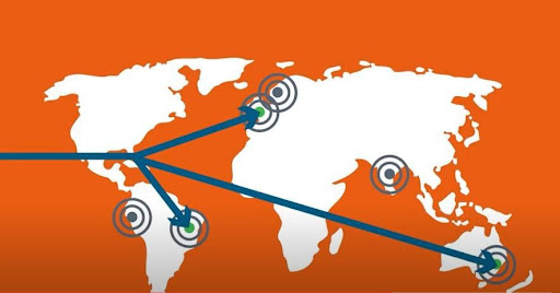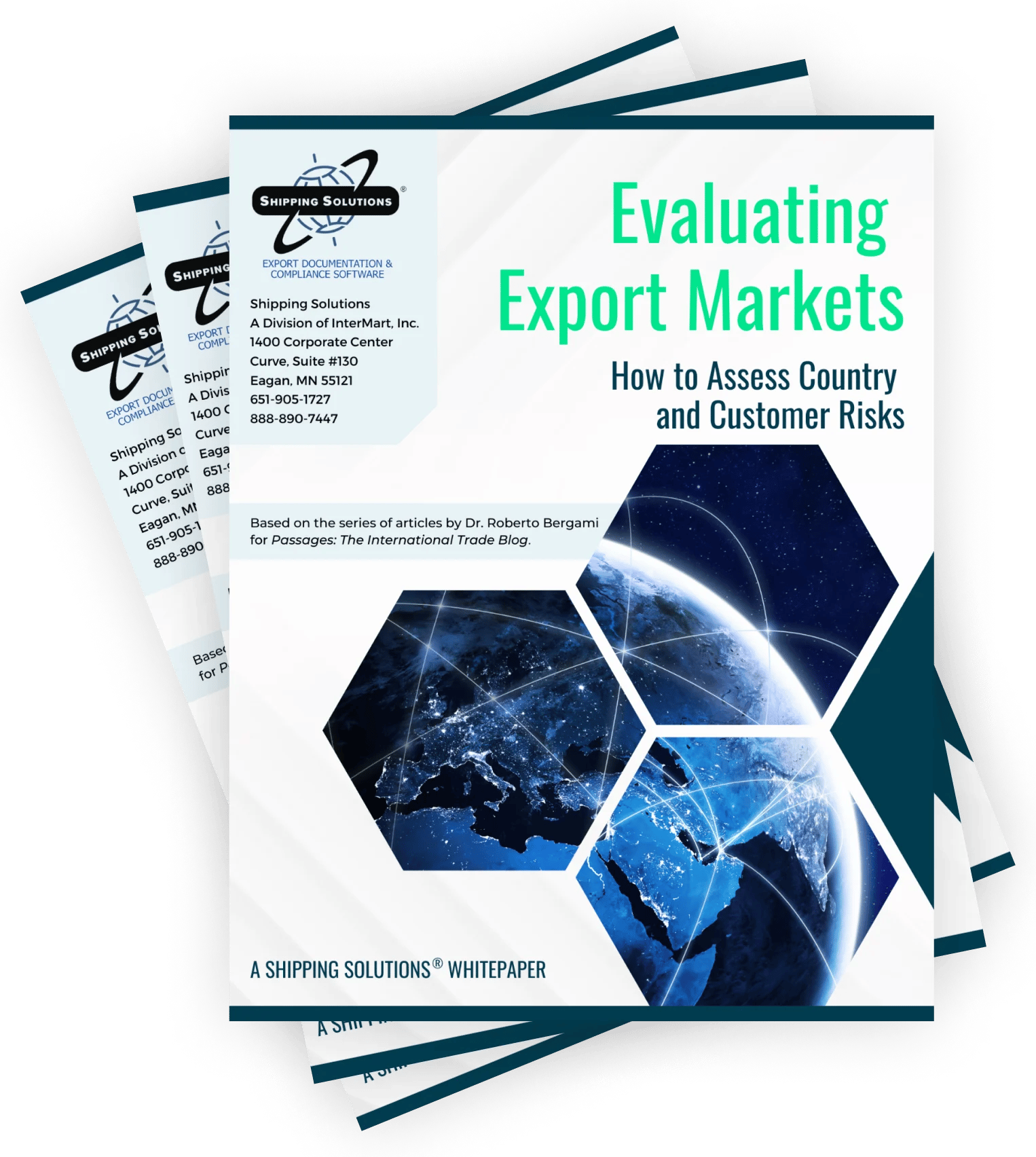The International Trade Blog International Sales & Marketing
Growing Your Sales: Are You Targeting the Right Export Markets?
On: December 1, 2021 | By:  Sandra L. Renner |
10 min. read
Sandra L. Renner |
10 min. read
 Targeting high-potential export markets is one of the most arduous and, at the same time, most impactful processes a company can undertake.
Targeting high-potential export markets is one of the most arduous and, at the same time, most impactful processes a company can undertake.
Ask company executives how they chose their export markets and, in many cases, the response will be that the market basically chose them. This can be a natural evolution whereby the company is contacted by someone who wants to buy their product or serve as a distributor in a particular market. Over the years, a company can end up with representation in a significant number of countries based on opportunity rather than strategy.
On the other hand, there are companies that are not selling in any export markets but want to start an exporting program. Where do they start?
Whether a company is new to exporting and looking to enter its first export markets or an existing exporter intending to expand into new markets, both companies could benefit by embarking on a targeting process that would help to ensure their commitment of resources to export markets would yield the greatest return.
Why Target Specific Markets?
Too often, we spend our time reacting to inquiries from other countries rather than taking a proactive position that focuses the company’s resources on a targeted number of high-potential country markets. If your company has limited resources for its global expansion effort, the strategy should be to target a limited number of high-potential markets and proactively apply a significant portion of the company’s available resources to enter, expand and penetrate those markets.
For the rest of world (ROW) or non-target markets, the strategy should be to allocate only limited resources to react to inquiries. If you apply the 80-20 rule, you would allocate 80% of the company’s resources to proactively target areas you have identified as high-potential markets that will produce 80% of results. Conversely, you will apply 20% of the company’s resources to react to the ROW markets that will produce only 20% of results.
Thus, the primary reason for targeting markets is that the opportunities for global expansion are usually greater than your limited resources, and you want to proactively focus on the highest-potential markets rather than letting others pull your company’s resources into low-potential markets.
How Do You Target Markets?
The most effective way to tackle the targeting process is to think of it as a funnel going from many markets and very broad screening criteria to few markets and very specific screening criteria.
The top of the funnel will include a broad array of Countries of Interest from which you will identify Potential Markets (Screen #1) and then Best-Prospect Markets (Screen #2) and finally your High-Potential Markets (Screen #3). If you keep updating your information during your annual planning process, over time Best-Prospect Markets might move into the High-Potential Markets category and become new target markets. Initially completing this process can be challenging. But, once completed, you will have a wealth of information from which to base your decisions. Should you decide to focus on lower-potential markets, you will have gained insights to perhaps offset some of a market’s shortcomings or anticipate obstacles that may not have been apparent.
Starting the Process: Establish Countries of Interest
You may be tempted to start with a very small number of countries based on past inquiries, conventional wisdom in the industry or other criteria. However, you should consider starting with a very broad list of countries.
There are almost 200 countries in the world. There is probably high potential for your product in countries that you will miss if you select a very limited group of countries. Therefore, you might consider starting with all countries in the world. Alternatively, if you are focusing on only a specific region of the world, you might select all the countries in that region. Either way, as you go through the targeting process you will narrow the countries down to relatively few high-potential target markets based on a three-level screening process.
What’s Next: Establish Market Selection Indicators
Next you will need to establish three sets of Market Selection Indicators to be researched and applied against country markets as they move through the funnel from Potential Markets (Screen #1) to Best-Prospect Markets (Screen #2) to High-Potential Markets (Screen #3).
The three broad categories of market indicators include environmental indicators, product indicators and “other” indicators. Environmental indicators are useful in identifying the general business environment and the basic need potential of the market. Product indicators point directly to your specific product and include an assessment of hurdles and other indicators of your ability to be successful in the market. The “other” indicators are an array of factors that could apply to your product.
Whatever your product, there are indicators of demand that you explicitly or intuitively use to target your marketing program in your domestic market. What are the indicators of demand in your domestic market? In the global market, the indicators of demand may be similar to your domestic indicators adjusted to different environments, cultures, regulations and so forth. In this task you will begin to define the global market indicators for your product. You will use a mix of indicator types—data, market intelligence, expert opinion—to determine the highest potential markets for your product.
Ready for Screen #1: Identify Potential Markets
Let’s assume you’re starting off with a large number of Countries of Interest. You will want to use Market Selection Indicators for Screen #1 that will be relatively easy to collect for all of the Countries of Interest and will enable you to eliminate those countries that don’t meet a minimum threshold. This first screen might focus on indicators such as the following:
- Demographic: Population, growth rates, age structure, birth rate, urbanization.
- Economic: GDP, GDP growth, GDP per capita, household income, private consumption, interest rate, exchange rate, convertibility of currency, economic stability.
- Ease of Doing Business rankings.
- Trade Agreements with the U.S.
- Other
Screen #2: Identify Best-Prospect Markets
The next task in the targeting process is to narrow the list to your Best-Prospect Markets. You will start your screen with the limited number of countries selected in the Screen #1 for Potential Markets task and apply the Screen #2 market indicators. The market indicators for Screen #2 will be more challenging to obtain but, fortunately, you’ve already narrowed the country list significantly. This second screen might focus on indicators such as the following:
- Social/Cultural: Education levels, literacy, family structure, ethnicity, language, religion.
- Political: Patent and trademark protection, legal system, international organization participation, political stability.
- Business: Practices, culture, rule of law.
- Export hurdles: Export restrictions from your country to the market.
- Import hurdles: Tariffs, non-tariff barriers, product standards.
- Use hurdles: Cultural, lifestyle, technical, product life cycle.
- Demand: Size, growth rate.
- Customers: Need for product, ability to afford product, market segments and size.
- Infrastructure: Ports, inland transportation, rail transportation, communications.
- Inquiries: Requests for the product received from foreign markets.
- Other
Once again, you will apply the weights and calculate a total weight for each country. This weight, along with your judgment, can be used to identify and rank the second round of country markets (e.g., 10 to 15) as Best Prospect Markets.
We’re nearing the narrow end of the funnel.
Screen #3: Select High-Potential Target Markets
The Market Indicators for Screen #3 will likely be the most challenging to obtain as they really drill down into the demand and competition for your specific product. Below are examples of the types of Market Indicators that might be used for Screen #3:
- Industry sector: Production, rate of growth, number and size of local competitors, strengths and weaknesses of industry, imports of product from your country/world, exports of product to your country/world, competitors’ imports to country.
- Distribution: Defined distribution channels, distribution agreement laws and practices.
- Competition: Price, quality, service, technology, promotion, market share by domestic competitors, market share by non-domestic competitors.
- Complementary products: Size of demand for complementary products or products on which your product may piggyback.
- Expert opinion: Your judgment, industry leader opinions.
- Unique indicators: There will undoubtedly be very unique indicators for your product that you will develop.
As with Screens #1 and #2, you will once again apply weights and calculate a total weight for each country. This weight, along with your judgment, can be used to identify and prioritize your High-Potential Markets. There may be critical country markets that you want to either include or exclude in the final list of high-potential target markets. Again, use your judgment in making your final selection.
How many country markets should be included in the high-potential list?
The number of target markets into which you plan to focus your global expansion program will depend on the resources your company has allocated to the program.
If your global expansion resources can address all the listed High-Potential Markets within the current planning cycle, then consider these markets prioritized markets. However, if your resources are limited, you may want to deselect one or more of the target markets for the current annual planning cycle. The deselected, or secondary, target markets may be phased into the global expansion program over time.
At the conclusion of the targeting process you will have divided the world into three categories:
- Prioritized Target Markets: Markets to be entered or expanded in the current planning cycle.
- Secondary Target Markets: Markets to be phased in over time.
- ROW Markets: All the non-target country markets in the world.
Market Indicators: Assigning Units of Measure and Weights
Each selection indicator will need to be assigned a weight scale. This scale will be used to calculate a weighted-rank order for a specific indicator. It will also be used to sum up a total weight for the indicators for a specific country. The total weight will help you to identify and prioritize the highest-potential markets and select the markets that will be used in your next screen.
The units of measure would be whatever makes sense for a particular indicator such as number, dollars, percentages, volume and other customary units of measure. The weights that will be assigned for each indicator (e.g., Per Person GDP at under $5,000 = 1, between $5,000 and under $10,000 = 3, etc.) need to be defined using a scale such as 1 to 10.
Undoubtedly, some indicators will be more important in selecting your target markets than others. Therefore, when you are assigning weights for an indicator, important indicators may be scored on a 1-to-10 scale while less important indicators may be scored on a 1-to-5 scale. By using a higher scoring scale for the important indicators, you will give them more weight in the weighted-rank order process.
Where to Look for Target Market Indicator Information
As you establish your market selection indicators, you will also need to identify where you might source your data and information. In this process, you may find it necessary to adjust your indicators based on the availability and cost of the desired data and information. By specifying the sources, you will be able to update the data and information in your screening tables as the need arises over time.
Several sources can be used for collecting indicator data and information on almost every country market. These sources include:
- U.S. Census Bureau
- Customs information
- Euromonitor
- Kompass
- United Nations
- U.S. Central Intelligence Agency World Factbook
- U.S. Department of Commerce
Some of the sources are fee based but may provide free access to low levels of data and information. Government agencies in the country of export may be some of the best sources of free or low-cost foreign market data and information. While many people use standard forms and tools to populate the information, there is also newly developed software by FasTrack Globalizer to guide you through this process. The FasTrack Globalizer software allows you to input, analyze and share information with your colleagues, all in a cloud based system to help you better manage your global strategy.
Your company’s records and database may be primary sources of data and information (e.g., quality foreign inquiries). You may need to review government export marketing reports; scan industry journals for market and competitor information; and talk with experts in government agencies, industry associations and known exporters in your industry (including domestic and foreign competitors).
Your search for secondary and primary sources of selection indicator data and information can go on endlessly, but don’t let it. Your primary purpose is to make a rational judgment about the highest-potential markets for your product based on reasonably available and accessible data, market intelligence and expert opinion. In future annual planning cycles you will reiterate this targeting process and continue to improve the sources for and quality of data and information.
If your product fits neatly into a narrow product classification code, collecting data may be easier than if the product is included in a broad product classification code or is a service or technology. For these types of products, finding relevant data and information for an indicator may, in some cases, become more challenging and require more creativity or, in other cases, become easier (e.g., you identify a complementary product for which there is abundant data/information).
All data and information needs to be weighed against the test of common sense. For that reason, it is imperative that you use your own judgment, as well as seek out the opinion of experts in your industry and market intelligence sources. Review trade journals, contact your trade associations, discuss your potential markets with government agencies, talk with known exporters to the country, quiz foreign visitors you meet at trade shows and so forth.
Worth the Effort: Benefits Will Be Realized Companywide
This targeting process, particularly if updated as part of major planning cycles, will enable you to focus on those markets that truly offer the greatest return. If product modifications are required, you will be more confident making that investment, leading to greater competitive advantage in a high-potential markets. Personnel throughout the organization can become expert in selling to and servicing those markets that are going to generate the greatest return and long-term growth for your company. And, you might be surprised by the markets that you’ve been overlooking, as well as those where you’ve been “spinning your wheels.”
Like what you read? Subscribe today to the International Trade Blog to get the latest news and tips for exporters and importers delivered to your inbox.

About the Author: Sandra L. Renner
Sandra is founder and chair of FasTrack Global Expansion Solutions and a national leader in the export and global trade community. She is the founder and president of Global Resource Associates and is currently chair of the Minnesota District Export Council, an associate member of the National Association of District Export Councils where she serves on the Trade Policy & Legislative Affairs and Outreach & Education Committees, and is a member of the U.S. Global Leadership Coalition (Minnesota Chapter). Previously she served as director of export development for the Minnesota Trade Office and was an instructor at Minnesota State University. Sandra is co-author of the book “Fast-Track Exporting” and the manual series “FasTrack Export Step-by-Step Process.” She is a recipient of many awards including the U.S. Presidential ‘E’ Award and the Medical Alley Association meritorious service award. Sandra has a B.S. in marketing and international business and a MBA from Minnesota State University-Mankato.



